Companion planting can turn your small garden into a colorful paradise! Imagine bright marigolds dancing next to juicy tomatoes, creating a feast for both the eyes and the taste buds. Plus, plants like carrots and onions work together to keep pesky bugs at bay. It’s like having a natural defense team! With these clever pairings, your garden thrives, and the soil gets healthier. Curious about more perfect plant pairings and tips? You won’t want to miss what’s next!
Benefits of Companion Planting in Limited Space
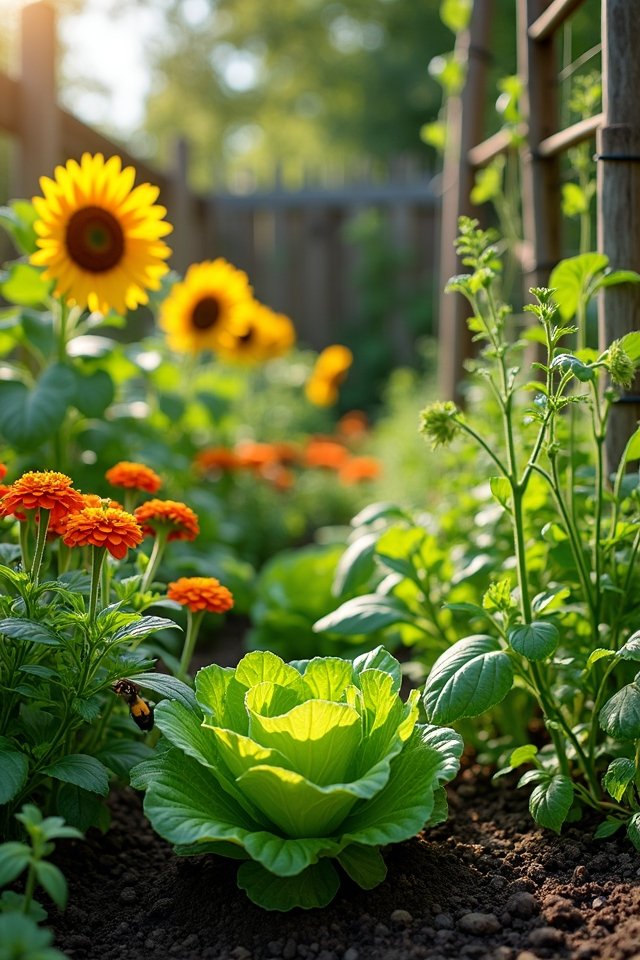
When you’re working with a small garden, every inch counts, right? That’s where companion planting shines! By mixing crops, you boost crop diversity, creating a thriving ecosystem. Picture charming marigolds you plant alongside vegetables, warding off pests while adding splashes of vibrant color! Who doesn’t love a garden that’s both functional and beautiful? Using this technique, you can maximize limited space, ensuring every plant plays its part. Plus, the interplay of colors and textures enhances plant aesthetics, making your tiny corner of paradise pop! You’re not just growing food; you’re creating a feast for the eyes, too! So, why settle for a monotonous garden when a cohesive, diverse space is just a few companion plants away? Let’s get innovative!
Best Companion Plant Pairings for Small Gardens
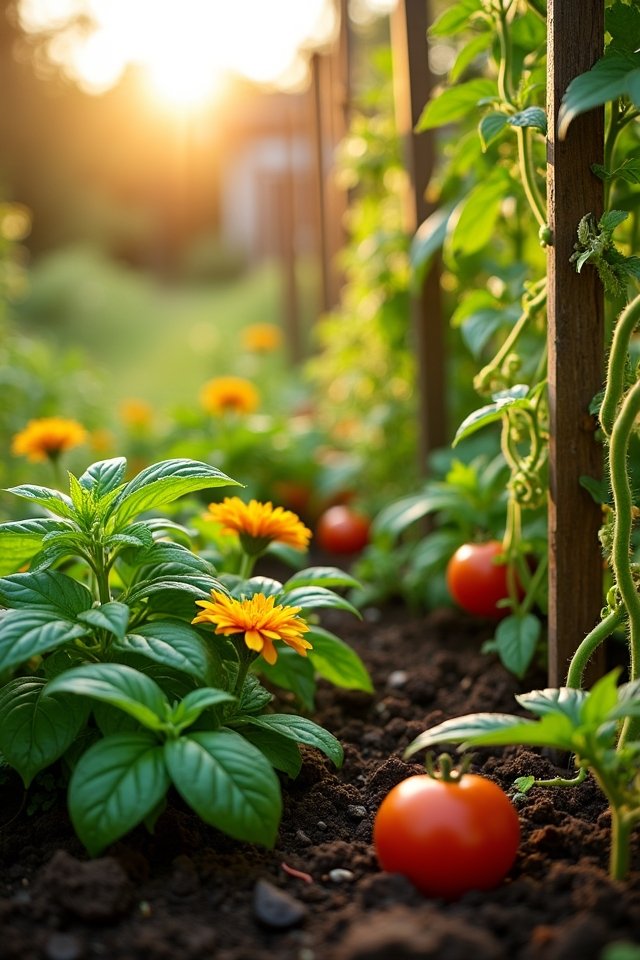
You’ll love how companion planting transforms your small garden into a vibrant oasis! Imagine this: tomatoes snuggling up to basil like old friends, enhancing each other’s flavors. How about pairing carrots with onions? Those veggie companions ward off pests while you savor sweet, crunchy roots!
For herb pairings, think about rosemary and sage, creating an aromatic duo that’s perfect for your culinary adventures. And don’t forget nasturtiums—they bring beauty while protecting your veggie pals from pesky aphids!
Embrace the magic of these pairings, and watch as your garden blooms with life and excitement! With thoughtful combinations, your little patch of earth can offer a delicious, bountiful harvest—who wouldn’t love that? Immerse yourself in this joyful gardening journey today!
How Companion Planting Enhances Soil Health
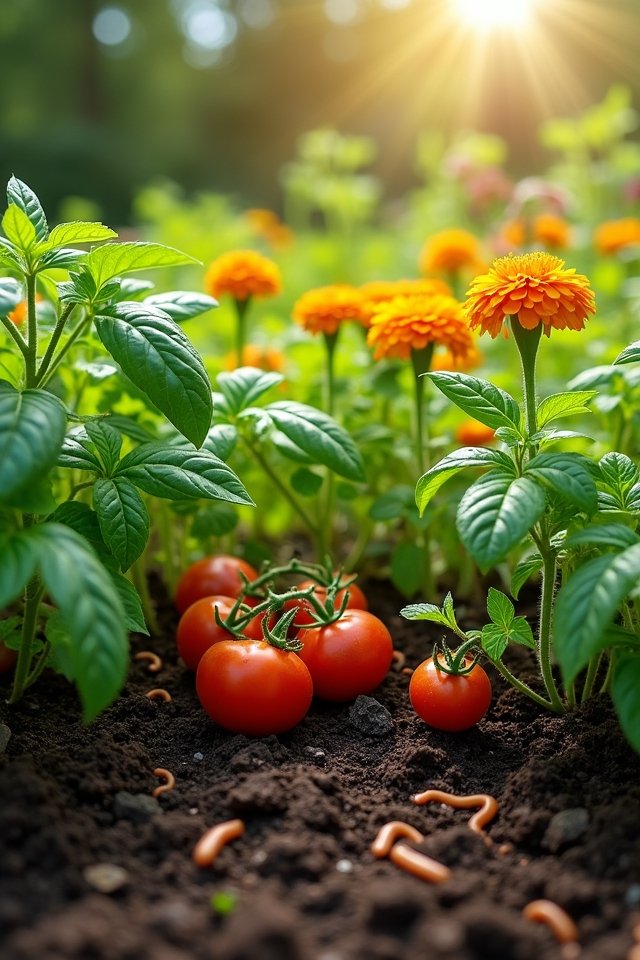
While you might think of companion planting as just a way to boost plant growth, it also works wonders for soil health! Imagine your garden’s soil transforming into a nutrient-rich haven, all thanks to plant symbiosis. For example, when you pair legumes like beans with corn, the beans fix nitrogen, feeding the corn and enhancing those soil nutrients. It’s like a nutrient party underground! Plus, plants can shade each other, preventing soil erosion and keeping it moist. Ever seen a dance-off between tall sunflowers and low-growing basil? Just as they flourish together, they enrich the earth, creating a vibrant ecosystem! So, explore companion planting—your soil will thank you with healthier plants and bountiful harvests!
Pest Management Through Companion Planting
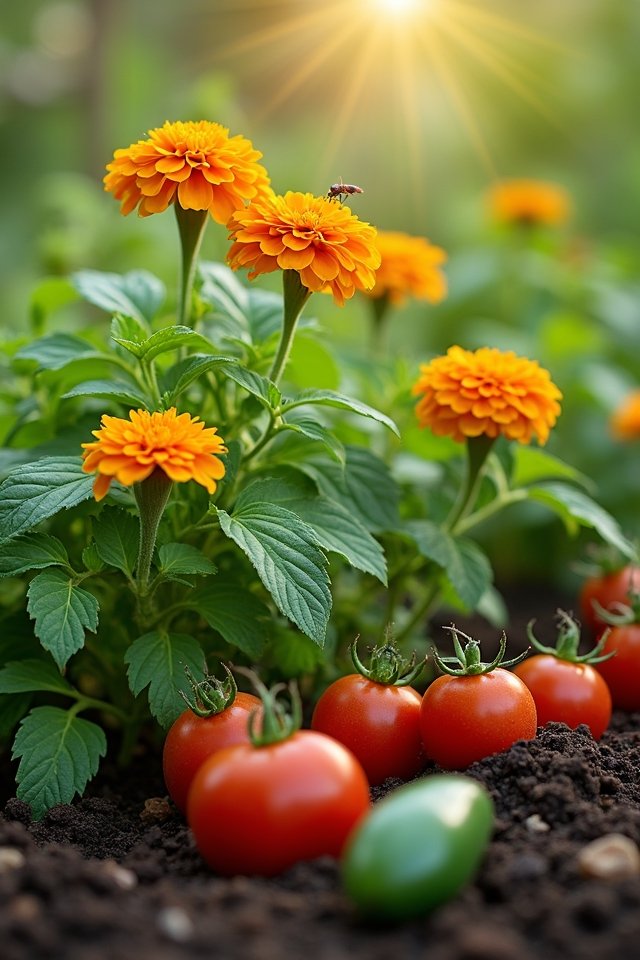
Think of your garden as a bustling community, where every plant plays a part in keeping the peace! By mixing certain species together, you can create a dynamic friendship that acts as a natural repellent against pests. For example, planting marigolds alongside your tomatoes works wonders! These bright beauties attract helpful insects while deterring those pesky aphids.
And did you know that herbs like basil are not just tasty? They repel flies and mosquitoes too! Imagine walking through your garden, surrounded by vibrant colors and sweet scents, all while being shielded from unwanted pests. It’s a win-win! So, why not harness the power of companion planting? You’ll enjoy a thriving garden that truly has your back!
Maximizing Yield With Strategic Plant Placement
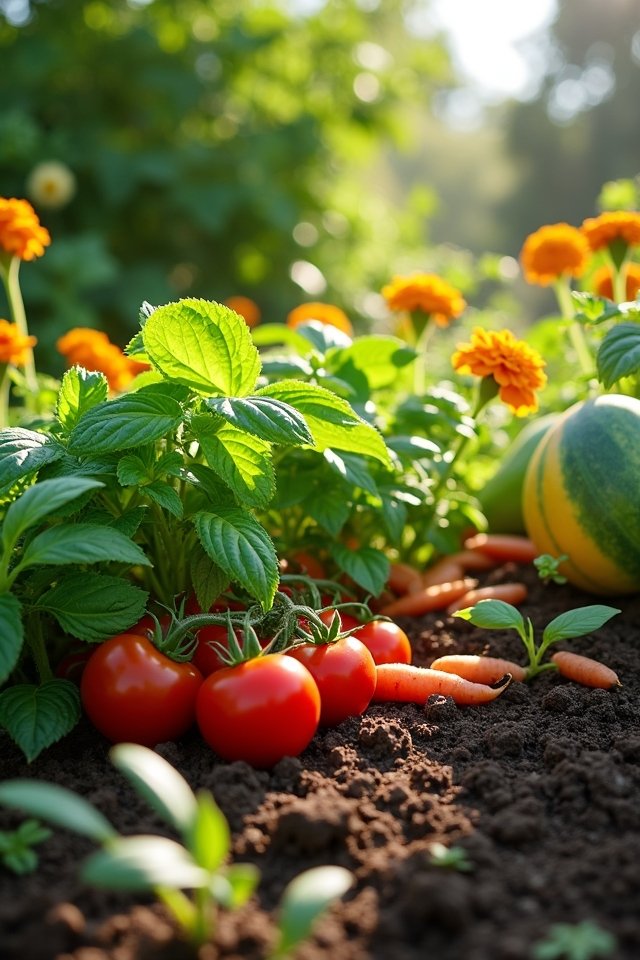
By planting with purpose, you can turn your small garden into a fruitful wonderland! Ever thought about crop rotation? It’s like giving your plants a mini vacation from pest problems and soil fatigue! Pairing tall plants with shorter ones makes the most of your vertical gardening space. Imagine sunflowers leaning over basil, creating a delightful sun-drench for your flavorful herbs below. Not only does this look stunning, but it also maximizes sunlight and encourages growth. And don’t forget to mix it up! Swap out your crops seasonally. Your garden will thrive like a superstar, looking fresh and vibrant all year long. So, why not strategize where you place each plant? It’s a game-changer! Happy planting!
Frequently Asked Questions
Can Companion Planting Improve the Flavor of My Vegetables?
Did you know that companion planting can boost vegetable flavor by up to 20%? Imagine biting into a juicy tomato that’s practically bursting with sweetness! Aromatic herbs, like basil and oregano, increase flavor enhancement when planted alongside your veggies. They attract beneficial insects and repel pests. So, why not surround those tomatoes with aromatic friends? Your taste buds will do a happy dance! Let’s get planting, and turn that garden into a flavor paradise!
How Do I Choose Companions Based on Plant Height?
When you’re choosing companions based on height compatibility, think of it like creating a layered cake! You want taller plants, like sunflowers, to stand proud, while shorter buddies, like lettuce, nestle snugly below. This layering technique maximizes space and sunlight! Try pairing carrots with radishes; radishes mature quickly, leaving room for carrots to grow. Mixing heights not only looks stunning, but it also spices up your garden like a flavorful dish! Isn’t that delightful?
Is There a Specific Planting Schedule for Companions?
They say, “Good things come to those who wait,” but you don’t have to wait long with companion planting! Check your planting calendar to align companions with seasonal considerations. For instance, sow beans near corn in late spring for a delightful duo that benefits both! Remember, timing is everything—tomatoes love warmth, so plant them after the last frost. Have fun experimenting, and let nature surprise you with vibrant harvests!
Can Companion Plants Deter Pests Without Chemicals?
Companion plants create natural repellents that can scare pests away without a single chemical in sight! For example, marigolds are like tiny orange guards, deterring nematodes and aphids with their potent scent. Basil’s aroma? It’s a deliciously fragrant way to keep flies and mosquitoes at bay! When you pair these beauties together, you’re not just planting, you’re orchestrating a garden symphony of pest deterrents! Isn’t nature amazing?! 🌼
What Plants Should I Avoid When Companion Planting?
Imagine planting a delightful garden only to discover some neighbors are more harmful than helpful! When companion planting, steer clear of plants like potent tomatoes and sun-napping potatoes—they can create serious plant incompatibilities. Melons and cucumbers? They’re not best buds either! Choose wisely; otherwise, you’ll find your garden’s harmony disrupted. Remember, just like people, some plants are better off avoiding each other! Happy planting, and may your garden thrive beautifully!


